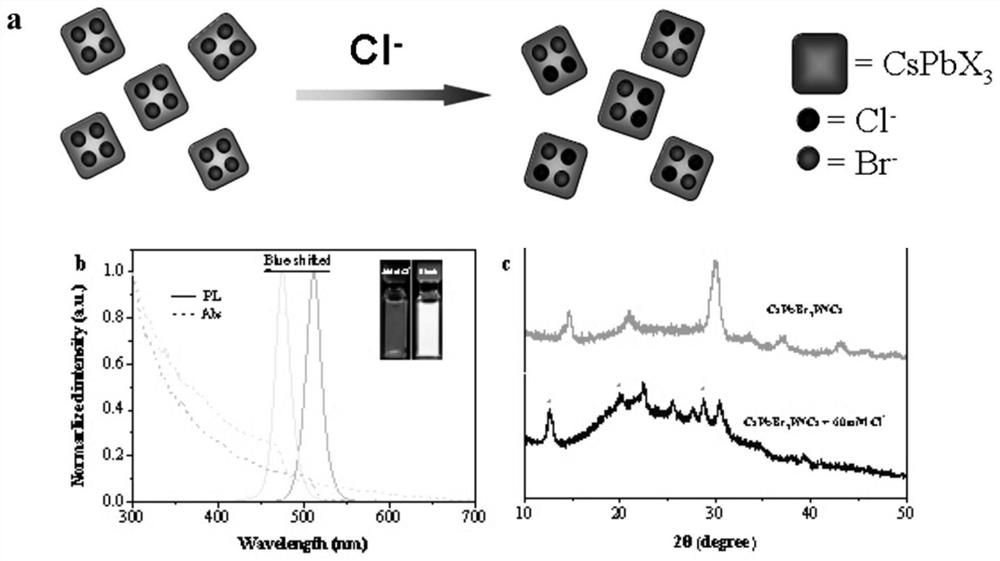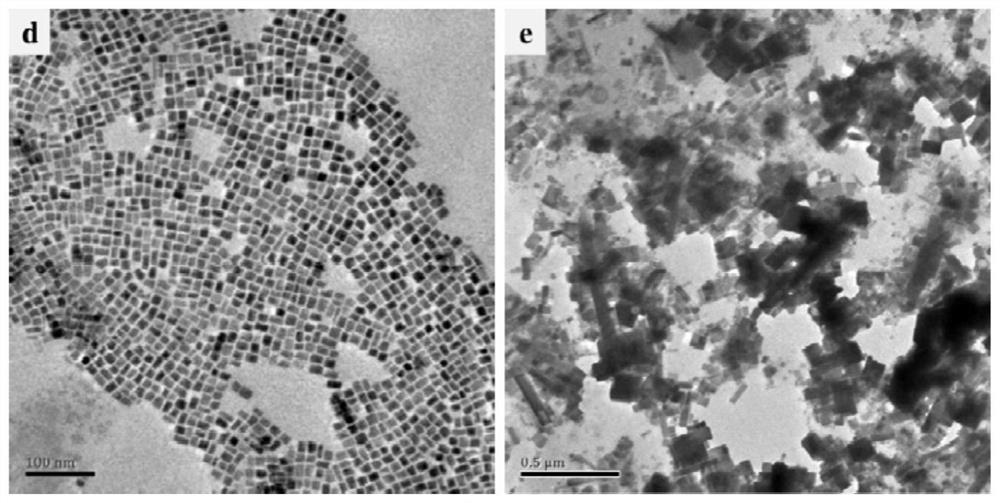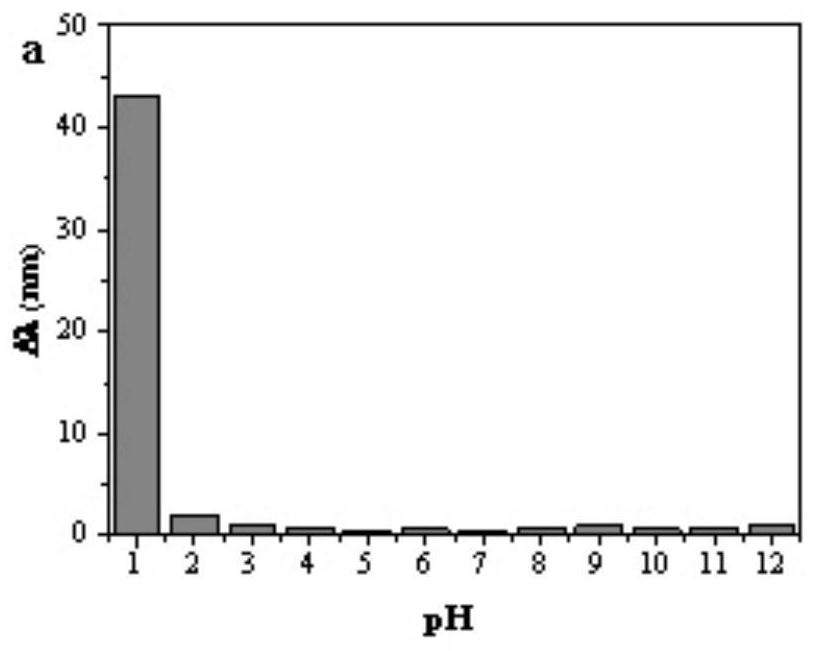A Visual Sensing Method for Chloride Ion Detection in Sweat
A technology for chloride ions and sweat, applied in the field of visual sensing to detect chloride ions in sweat, can solve problems such as complex construction, achieve good reproducibility, easy operation, and high sensitivity
- Summary
- Abstract
- Description
- Claims
- Application Information
AI Technical Summary
Problems solved by technology
Method used
Image
Examples
Embodiment 1
[0054] Preparation of perovskite nanocrystals (CsPbBr 3 PNCs), the steps are: 5mL ODE, 0.75mL OAm, 0.016gCs 2 CO 3 And 0.0387g PbSTR, 0.071g TBB were added into a 25mL three-neck flask in turn, stirred vigorously at 2500rpm, and directly heated to 160°C in air, and finally cooled naturally.
[0055] The obtained primary product was washed with a mixed solvent of ethyl acetate and n-hexane (V ethyl acetate / V n-hexane = 3:1), the rotation speed was 10000 rpm, the centrifugation time was 10 min, and the washing and purification were performed three times. The bottom product was taken and discarded Clear liquid, and disperse the final product in n-hexane solvent for later use.
[0056] Take 1mL of the above CsPbBr 3 PNCs solution, add 5 μL NaCl aqueous solution (10-130 mM) of different concentrations, and then add 5 μL 0.1M H 2 SO4 dilute sulfuric acid solution. After stirring at 1500rpm for 5min, select the excitation wavelength of 365nm, and collect CsPbBr with F-7100 fluor...
Embodiment 2
[0062] In order to obtain the best sensing performance, the experiment investigated the influence of reaction conditions solvent pH, stirring speed and reaction temperature, and CsPbBr 3 The above conditions were optimized for the wavelength shift of PNCs after adding 60mM NaCl to the reaction.
[0063] The experiment explored the effect of pH on the sensing system.
[0064] Experimental results such as image 3 As shown, the experiment found that under magnetic stirring, only when the medium pH=1, the Cl in the water phase - Fangneng and CsPbBr dispersed in n-hexane 3 PNCs perform halogen exchange, but it is difficult to perform effective halogen exchange under other pH conditions. The reason for this phenomenon may be that Cl - Protonation under strong acidic conditions forms HCl, which facilitates its diffusion into n-hexane solution, and then combines with CsPbBr 3 PNCs undergo rapid halogen exchange, and it is difficult to effectively convert Cl- to HCl at other pHs,...
Embodiment 3
[0068] In order to investigate the selectivity of the method, an interference experiment was carried out before the actual sample analysis.
[0069] The experiment selected common substances or similar substances in sweat such as NaF, NaBr, NaI, K 2 SO 4 , MgSO 4 , Ca(NO 3 ) 2 , Fe(NO 3 ) 3 、Na 3 PO 4 、Na 2 CO 3 , MgSO 4 , NaHCO 3 , NaH 2 PO 4 , urea, ammonia, glucose, arginine and lactic acid, etc. for interference experiments. Interference experiments The sensing and detection of interfering substances was carried out as described in Example 1.
[0070] The results of interference experiments are as follows Figure 5 shown. Based on CsPbBr 3 PNCs and Cl - Halogen exchange achieved for Cl in sweat - Fluorescence visual sensing has good selectivity, the reasons are as follows: (1) NaCl is the main component in sweat (average level is about 23mM), which is higher than other components; (2) the halogen exchange specificity. Although the concentration of lact...
PUM
| Property | Measurement | Unit |
|---|---|---|
| particle diameter | aaaaa | aaaaa |
Abstract
Description
Claims
Application Information
 Login to View More
Login to View More - R&D
- Intellectual Property
- Life Sciences
- Materials
- Tech Scout
- Unparalleled Data Quality
- Higher Quality Content
- 60% Fewer Hallucinations
Browse by: Latest US Patents, China's latest patents, Technical Efficacy Thesaurus, Application Domain, Technology Topic, Popular Technical Reports.
© 2025 PatSnap. All rights reserved.Legal|Privacy policy|Modern Slavery Act Transparency Statement|Sitemap|About US| Contact US: help@patsnap.com



